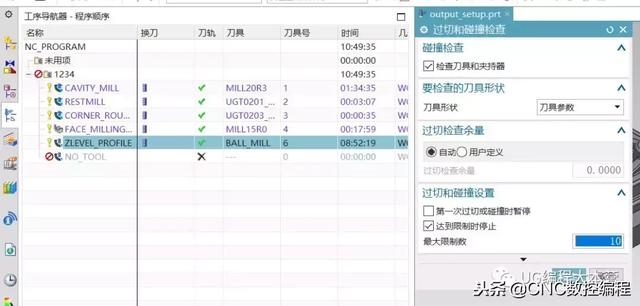
Follow Rokotech and learn the latest information in the industry
1. Precautions for copper processing
① Cutter path sequence of copper common machining: rough cutting of flat cutter curved surface grooving cutter path (or rough cutting of flat cutter profile milling cutter path)
--Ball cutter parallel milling cutter surface light cutter
--Ball knife contour knife path side light knife
--Flat cutter profile milling cutter path calibration table reference plane light cutter
② The machining allowance during roughing is 0.2-0.5.
The tolerance of light knife is 0.005 --- 0.02,
The step is 0.05-0.3,
Machining allowance is -0.1mm-0.3mm
2 precautions for front die processing
① Cutter path sequence: large cutter curved surface grooving cutter path roughening, small cutter contour cutter path roughening, large cutter (ball cutter) parallel milling cutter path light cutter, small cutter parallel milling cutter path light cutter. When the front mold is manufactured, there is usually a copper male matched with it, mainly to open a rough knife path, supplemented by a local curved surface light knife.
② With parting surface and pillow surface, it shall be added together. The parting surface and pillow surface shall be processed in place without allowance, and 0.2-0.5 allowance shall be reserved at the cavity for sparking. If there are only young males, leave a margin of 0.3. Both young and coarse males are sometimes, and an allowance of 0.5 can be reserved. A margin of 0.1 can be reserved at the collision and abrasion positions of the front die for the matching of the front and rear dies.
③ Use a large diameter round nose knife (knife handle) when opening the rough. If the diameter of the knife is too small, it is easy to break and spring the knife. Also try to use it when cutting.
④ The tool path range in surface machining is calculated based on the moving track of the tool center axis, that is, the actual machining area is one tool radius value larger than one side of the selected tool path range limit box, and the parameters of the tool path range limit box should be set reasonably. Avoid the processing range exceeding the actual processing needs.
⑤ The front mold material is hard. Check carefully before processing to reduce errors. You can't burn and weld easily!
3 precautions for rear mold processing
① Rear die cutter path sequence: large cutter surface grooving, cutter path roughing, small cutter limit range, surface grooving, roughing, angle clearing, large cutter (ball cutter) parallel milling path smooth surface, small cutter (ball cutter) parallel milling path limit range, angle clearing, smooth cutter, flat cutter contour path angle clearing.
② The material of the rear die is the same as that of the front die, and the round nose knife (knife handle) shall be used as far as possible.

4cnc machining precautions
A. Mold and product fit tolerance
① The matching and positioning of the upper and lower shells is ensured by the stop, and the tolerance of concave stop and convex stop is generally 0.1 on one side
② Generally, the shape of accessories (such as transparent mirror) on the large body of the shell is 0.1-0.2 smaller than the size of one side on the large body
③ The shape of movable accessories (such as buttons) on the large body shall be 0.1-0.5 smaller than that on one side of the large body
④ If the surface shape of the fitting is consistent with the surface shape on the body, it can be trimmed from the corresponding position on the body surface.
B. Selection of cutting point
When writing the knife path, you can lower the knife at any specified height and position. When the first knife starts processing, the amount of knife is often large, which is easy to cause knife breaking and bouncing. At this time, you can open the lower knife position or empty the first layer of knife, and try to lower the knife outside the material. This problem must be paid attention to.
C. Grabbing knife, bouncing knife and dropping knife
This kind of phenomenon often occurs when the feed is large, the tool clamping length is too long and the tool diameter is small.
When machining at the position with the same corner radius and tool radius, it is easy to have inaccurate overall dimensions, which is called grabbing tool ----- you can use the tool with smaller diameter to clear the corner layer by layer, and then change the larger tool light side. When the depth is low and large, it can be processed in layers.

D. Overcut inspection
Over cutting is a common problem, which should be paid special attention. The solution is to simulate the tool path once and check it repeatedly from various angles. The tool path without inspection is not allowed to be machined. During contour milling, over cutting will occur if the cutting point is improperly selected, which can be avoided by changing the cutting point.
E. Contents of computer gong processing sheet
In order to facilitate communication with the operator, the processing order (program paper) shall include:
① NC program name
② Tool type
③ Tool diameter
④ Tool clamping length
⑤ Machining allowance
⑥ Knife path type (rough or light knife)
⑦ Original drawing file name (e.g. cnc1c: mc9acb01s. Mc9)
⑧ If there are special processing requirements, a sketch description shall be attached
F. Tool clamping length
It refers to the length left outside the tool collet after the tool is clamped with the collet. It should be as short as possible to improve the rigidity under the condition of ensuring no collision
Shenzhen Rokotech Electronic Technology Co., Ltd
Hotline: 0755-23728490
Fax: 0755-23728490
Tel: +86 13825258810 (Mr. An)
Address: floor 1, building 6, Shajing and yixinlianhe Industrial Park, Bao'an District, Shenzhen
Website: www.legaotech.com
